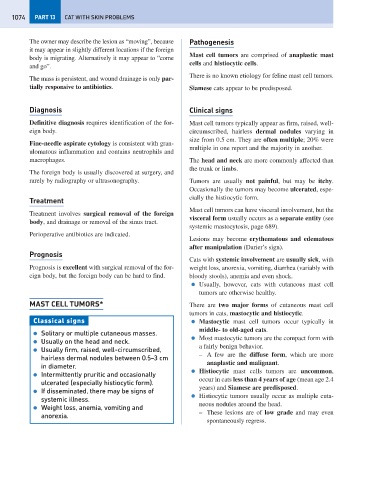Page 1082 - Problem-Based Feline Medicine
P. 1082
1074 PART 13 CAT WITH SKIN PROBLEMS
The owner may describe the lesion as “moving”, because Pathogenesis
it may appear in slightly different locations if the foreign
Mast cell tumors are comprised of anaplastic mast
body is migrating. Alternatively it may appear to “come
cells and histiocytic cells.
and go”.
There is no known etiology for feline mast cell tumors.
The mass is persistent, and wound drainage is only par-
tially responsive to antibiotics. Siamese cats appear to be predisposed.
Diagnosis Clinical signs
Definitive diagnosis requires identification of the for- Mast cell tumors typically appear as firm, raised, well-
eign body. circumscribed, hairless dermal nodules varying in
size from 0.5 cm. They are often multiple; 20% were
Fine-needle aspirate cytology is consistent with gran-
multiple in one report and the majority in another.
ulomatous inflammation and contains neutrophils and
macrophages. The head and neck are more commonly affected than
the trunk or limbs.
The foreign body is usually discovered at surgery, and
rarely by radiography or ultrasonography. Tumors are usually not painful, but may be itchy.
Occasionally the tumors may become ulcerated, espe-
cially the histiocytic form.
Treatment
Mast cell tumors can have visceral involvement, but the
Treatment involves surgical removal of the foreign
visceral form usually occurs as a separate entity (see
body, and drainage or removal of the sinus tract.
systemic mastocytosis, page 689).
Perioperative antibiotics are indicated.
Lesions may become erythematous and edematous
after manipulation (Darier’s sign).
Prognosis
Cats with systemic involvement are usually sick, with
Prognosis is excellent with surgical removal of the for- weight loss, anorexia, vomiting, diarrhea (variably with
eign body, but the foreign body can be hard to find. bloody stools), anemia and even shock.
● Usually, however, cats with cutaneous mast cell
tumors are otherwise healthy.
MAST CELL TUMORS* There are two major forms of cutaneous mast cell
tumors in cats, mastocytic and histiocytic.
Classical signs ● Mastocytic mast cell tumors occur typically in
middle- to old-aged cats.
● Solitary or multiple cutaneous masses.
● Most mastocytic tumors are the compact form with
● Usually on the head and neck.
a fairly benign behavior.
● Usually firm, raised, well-circumscribed,
– A few are the diffuse form, which are more
hairless dermal nodules between 0.5–3 cm
anaplastic and malignant.
in diameter.
● Histiocytic mast cells tumors are uncommon,
● Intermittently pruritic and occasionally
occur in cats less than 4 years of age (mean age 2.4
ulcerated (especially histiocytic form).
years) and Siamese are predisposed.
● If disseminated, there may be signs of
● Histiocytic tumors usually occur as multiple cuta-
systemic illness.
neous nodules around the head.
● Weight loss, anemia, vomiting and
– These lesions are of low grade and may even
anorexia.
spontaneously regress.

